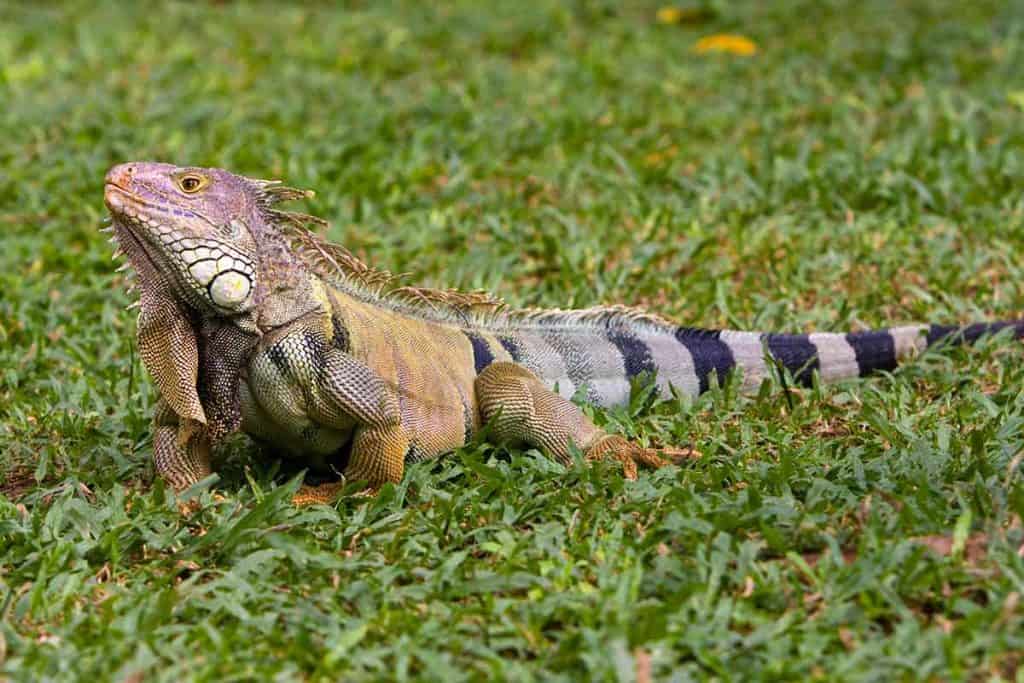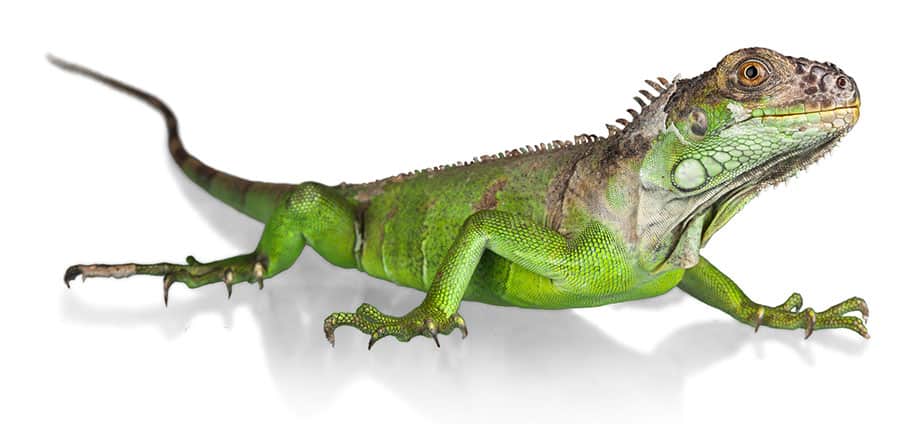Before embarking on the joys of owning a pet iguana, it’s important to do a little research on the basics about this intriguing reptile. First off, how big do iguanas get?
Iguanas start off very small and look manageable to most people at first. However, they grow up to be around seven feet in length! This massive lizard has moderate care requirements that, while costly, are relatively easy to set up and maintain.
Although iguanas aren’t terribly demanding pets, it’s important to keep in mind that their care requirements, such as food and enclosure size, are upsized with every step of their growth! You baby iggy can start out in a 40 gallon enclosure but will need to be moved to an enclosure the size of a small room very soon! You’ll need to take their size into serious consideration before you purchase one.
Additionally, these giant lizards grow at a rapid rate when they are very young. This slows as they get older, but they don’t reach their maximum size until they’re around seven years old. Read on to find out how big iguanas get and what you can do to support their growth!
Iguana Size and Growth Chart
Below is a growth rate chart for healthy males, but it can be used as a general reference for female iguanas, too. Green iguanas are sexually dimorphic, which means there are slight physical differences between males and females.
Females will reach around five feet in length and usually max out at 7 to 10 pounds, while males get a bit longer (up to seven feet) and can reach 20+ pounds (though they usually max out at around 15 pounds).
We recommend that you keep a growth chart for reference for your own green iguana while it is growing up. Keeping a chart like this will help you track your iggy’s growth and weight and will notify you pretty quickly if they are sick or something has gone wrong with their development.
Keep in mind the length indicated in this chart is the snout to the tip of the tail length. Some growth charts make a distinction between the snout to tail and snout to vent. Green iguanas’ tails make up around 40% to 50% of their length, so it is important to note which measurement is being used.
Growth Rate of Iguanas
As you can see in the growth chart, green iguanas grow incredibly quickly in their first year of life. They more than double their length from snout to tail tip, and they increase their weight by 50% during this time.
Once they reach a year old, their growth will slowly settle at a more ‘reasonable’ rate. Do not let this fool you, though; green iguanas can continue to grow in length and in weight until they are eight years old!
Your iguana’s growth may slow or even seem to stop between the ages of 4 to 7. Do not panic, as this is normal. Just continue their normal food schedule and double check all of their care requirements to ensure that their UVB and/or heat bulbs aren’t broken or need to be replaced.
Additionally, sometimes iguanas just take a bit of a break while they are growing, especially after their first year of life. This is part of why keeping a growth chart of your own is so important. Measuring your pet’s length and weight will help you accurately identify when there is a problem with their growth due to illness, malnutrition, or other health issues, for example.
If you are in the market for a iguana, take a serious look at the space that you have at home and know that a considerable amount of it will be taken up by your iggy’s enclosure!
5 Tips to Encourage Healthy Growth in Iguanas
While a green iguana’s maximum size is mostly determined by their genetics, there are many factors that can stunt their growth unnaturally, from improper nutrition to illness and even just poor husbandry.
Stunting your iguana’s growth, intentionally or not, is harmful to the animal and incredibly cruel. Make sure you always practice good reptile husbandry!
Use these five tips to ensure you help your iggy reach its healthiest length and weight!
1. Proper Enclosure Size
As we have indicated above, enclosure size is very important when keeping an iguana as a pet. They are very big lizards, and so they need a very big enclosure.
Green iggys are semi-terrestrial (land-dwelling), semi-arboreal (tree-dwelling), and also semi-aquatic (they love the water)! In fact, they are even semi-fossorial (burrowing)! This means they benefit from diverse enclosure setups with both vertical and horizontal space, water, and a bit of substrate to burrow in.
Keep these factors in mind when setting up your iguana’s enclosure to facilitate healthly growth:
- Their enclosure needs to have plenty of height for them to climb and explore trees or densely foliaged perches
- Their enclosure also needs to be long and wide enough for them to have floor space to roam around and get some exercise
- The enclosure’s floor should preferably have somewhere with lots of dense loose substrate that they can burrow in, but make sure they cannot escape. Wild iguanas have dug burrows that are so extensive they have caused roads to collapse!
- The enclosure must have adequate floor space for a large, deep water dish that they can fit their entire body into to soak. Green iguanas, like bearded dragons, love to swim and can hold their breath for up to four hours!
You cannot buy an adult’s enclosure from any pet store because they are so large and they need to fit your own home requirements. The enclosure sizes mentioned in the growth chart earlier are the absolute minimum sizes required for their size class, so always try to go a bit bigger if you can.
Most iguana owners either build their own enclosures for their lizards or have them custom built; this can get pricey, so be prepared to spend a bit on the initial setup regardless of which option you choose!
2. Adequate UVB Lighting
Like other pet reptiles, iguanas need lots of UVB to grow big and strong. If they are housed outside, then they should be able to get the right amount of UVB lighting from the sunlight that enters their enclosure.
However, if they do not get enough sunlight or they are housed in an interior enclosure that can’t be moved outdoors, then they need additional UVB lighting.
UVB lights do not travel a long distance, so you will likely need to have multiple UVB bulbs in the one enclosure as it increases in size.
Without the correct UVB lighting, your iguana cannot make enough Vitamin D or process
3. Correct Humidity Levels
Iguanas come from subtropical regions and therefore need fairly high humidity in their enclosures. If they do not have suitable humidity in their enclosures, they will suffer from respiratory infections and become lethargic and lose their appetites.
If the humidity is not high enough, they will also struggle to shed properly. Problems with shedding can cause their toes and even their tails to become necrotic and fall off due to “stuck shed.”
Make sure you have some kind of misting system in place; it can be an elaborate automatic setup, or you can simply opt for manual misting with a water bottle.
4. Adequate Quantity of Food
Iguanas are herbivores, more specifically folivores. They need a lot of food in the form of plant matter like greens, flowers, fruits, and veggies to grow and maintain their body weight!
Hatchlings and juveniles up to about 4 years old should be fed a decent-sized salad twice a day. Their salads should have lots of variety in them to promote interest in their food and provide them with a wide range of vitamins and nutrients.
Without enough food, your green iggy cannot grow or maintain their organs, muscles, or bones, and their growth will be stunted.
5. Quality of Supplements
All lizards need
Your iggy will get some of its
MBD is an incredibly painful disease where the bones and joints become very brittle and bend, twist, malform, and break. Very mild cases can sometimes be corrected with additional supplements. However, severe cases are irreversible and can be fatal.
Adding a multivitamin to their diet will also help them maintain a healthy growth rate by ensuring their nutritional needs are met.
FAQs About Iguana Size
Can I put my baby green iguana in an adult-sized enclosure?
You should not put a baby iguana in an adult-sized enclosure. The size difference in the iguana itself is massive, and so is the size difference in the enclosure. First, you can end up losing your baby iguana through gaps in the fencing in a larger enclosure.
Second, your baby iguana will experience severe stress and anxiety from being in such an open space while it is so small. Always match the size of the enclosure to your iguana’s current size to ensure optimal health.
Are there miniature green iguana morphs?
Green iguana morphs target their coloration and patterning rather than size. There are beautiful morphs that include blue and orange coloration, enlarged dewlaps, and elongated dorsal spines.
If you are looking for a smaller ‘large’ lizard, have a look at getting a chuckwalla, a blue tongue skink, an Ackie monitor, or a uromastyx.
Does my green iguana’s size change its life span?
A green iguana’s size does not affect its lifespan. However, bigger iguanas may have a shorter lifespan if their care requirements are not met correctly.
Green iguanas live to about 10 years old in the wild. However, in captivity, they can live for more than 20 years with careful care!
Chomping Off…
Green iguanas make great pets because they are beautiful to look at and are interesting and intelligent creatures. However, they are definitely not pocket-sized!
It is important to know how big your green iggy will get before you purchase it so you know what will be required of you as a reptile parent in the future. Green iguanas grow very quickly in their first year and will continue to grow at a steady rate for the next 7 to 8 years.
Be prepared for your prehistoric-looking lizard’s long life, and good luck!




